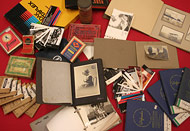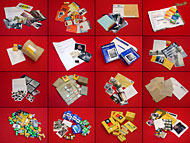How You Can Help
Help Create an Archive of Photographic Materials from the Pre-Digital Age

|
|
Digital photography is replacing traditional photography. And it's happening so fast that traditional photography, and the knowledge about how to create it, is in danger of disappearing altogether.
We need your help.
Scientists at the Getty Conservation Institute need your old photographic papers, film, negatives, and prints to build an archive of knowledge and materials from the era of classical photography. This archive will become a reference collection for future generations of photo conservators and scholars, and will allow them to research and authenticate the treasures of the classical photography era.
Surprisingly, the large photography companies—Kodak, Ilford, Fuji, Polaroid, and Agfa—did not save samples of the hundreds of different films and papers they developed over the last century.
We're hoping that you did.
Read about the scientific goals of this project.
What You Can Do
Send us samples of photographic paper and plates, film, negatives, sample books, and dated photographs. We need examples of all types of materials from every year since 1827. So, send us the box of Kodak Elite paper that might be collecting dust in your attic, that Foma film from 1985 that you think you'll never use, or the extra photographs from your 1988 (or 2006!) trip to Yosemite that didn't make it into your photo album.
We need samples that are dated and include the manufacturer's information. Even damaged materials are useful to us if they are stamped with a date and have the manufacturer's name or logo stamped on them.
Below are some examples of materials to send.
• Photographs—don't send us your family treasures; send the extra copies and rejects.
• Please only send photographs that have a date and/or manufacturer's name or logo printed on them.
• Instant photographs from Polaroid, Kodak, or other manufacturers.
• Unexposed film in the original canisters—black-and-white, color, and Polaroid. If you have the original packaging,
send that too!
• Unexposed photographic papers—ideally in the original box. If you have an unopened box you can part with,
this is especially helpful.
• Exposed photographic papers, including prints, contact sheets, and contact prints if they include a date and manufacturer's name or logo.
• Film, sheet, or glass-plate negatives, and transparencies.
Still not sure if you should send us your materials? Read our Frequently Asked Questions, below.
Think you have something really unusual? See a list of the highly-sought materials we're looking for (1p., PDF format, 27KB).
How to Send
Send materials to the Getty Conservation Institute at the following address:
Photographic Processes Research Project
Getty Conservation Institute
1200 Getty Center Drive, Suite 700
Los Angeles, CA 90049-1684
Before sending materials, please read our Legal Disclaimer.
Please include your name and a return address with your donation.
We will send you an acknowledgment once we receive your donation and will also add your name to a list of contributors that will live in perpetuity with this important archive. Let us know if you do not want your name added to this list.
Status of Archive

|
|
Our request for help in creating an Archive of Photographic Materials from the Pre-Digital Age (first posted in 2006), generated a very positive response from the photography-loving public, professional photographers, and art conservation colleagues around the world. We have received a number of important donations of photographic materials, photographs created using various photographic processes, and photographs from alternative photography photographers who are creating modern photographic art using many historical and often long abandoned photographic processes. Thus far donations have arrived from throughout the United States, as well as from countries around the world, including Canada, Russia, Italy, Belgium, Bulgaria, the Netherlands, the United Kingdom, the Czech Republic, Slovenia, New Zealand, France, and Argentina.
Since the initiation of this project, several more manufacturers of traditional photographic materials have discontinued production of those materials and our work to preserve the heritage of the chemical photography era is now even more pressing and important.
We continue to ask for your help and we greatly appreciate your support. We will use this Web site to provide you with periodic updates and with information on interesting aspects of the project.
What to Send Us
• What types of photographic materials do you need?
• How much should I send?
• My film isn't very old. Do you still want it?
• I have old, damaged film that may even have been exposed. Do you still want it?
Why Send Us Your Materials
• What will happen to my materials?
• Will my materials be returned to me?
• Will I be acknowledged for my donation to the project?
• Is my donation tax deductible?
How to Send Us Materials
• What is the best way to send these materials to the Getty?
• Will the Getty pay for me to ship the materials?
Questions about the Project
• Who will be able to use the archive?
• Are there other institutions creating archives like this?
• Why is it so important to get samples from each year?
What to Send Us
• What types of photographic materials do you need?
We need film, unexposed printing papers, and photographic prints. Photographs should be dated and include manufacturer's
information.
Please do NOT send us any cameras, processing equipment, or chemicals.
• How much should I send?
We need samples, not large quantities. For example, don't send us every print from the same roll of film.
Two or three prints from the same roll of film is plenty. Similarly, if you have 50 rolls of film from the
same manufacturer's batch, send us two or three rolls.
If you have unexposed film or paper in its original packaging, send the entire package and its contents, if you can. For example, an unopened box of unexposed paper is ideal since we can verify the manufacturing batch and date. It's not necessary to send more than one box from the same manufacturer's batch.
• My film isn't very old. Do you still want it?
Yes! We need samples of all types of materials from the entire history of classical photography. That's anything made
from 1827 up to today by all manufacturers, regardless of origin.
• I have old, damaged film that may even have been exposed. Do you still want it?
Yes! As long as it is dated and includes a manufacturer's name or logo, even damaged material has scientific value.
Why Send Us Your Materials
• What will happen to my materials?
The materials you send us will become part of an important archive of photographic materials. The archive will be publicly accessible to conservators, scientists, and researchers around the globe.
• Will my materials be returned to me?
No. Your materials will become part of a permanent archive. So, please don't send your family treasures. Send your rejects, extra copies, and anything you would throw away.
• Will I be acknowledged for my donation to the project?
Yes. We will send you an acknowledgement letter and add your name to the list of donors, which will become part of the archive.
• Is my donation tax deductible?
We expect donations to be of minimal value. Therefore, the Getty will not provide documentation for tax deduction.
If you want to donate valuable photographic materials to the Getty, please contact gciweb@getty.edu.
How to Send Us Materials
• What is the best way to send these materials to the Getty?
Send the materials using the service that is most convenient for you—the Getty accepts mail from all carriers, including the US Post Office, UPS, FedEx, and DHL.
You do not need to worry about wrapping the package in a special way.
• Will the Getty pay for me to ship the materials?
No. We are not able to reimburse donors for shipping. However, there are inexpensive shipping options.
The US Post Office's third class mail is less expensive than standard mail. You may be able to send the materials
through the US Post Office's Media Mail Service, which is significantly less expensive than standard mail. Check with
the Post Office.
Questions about the Project
• Who will be able to use the archive?
The archive of photographic materials will be housed at the Getty Conservation Institute in Los Angeles, and be open internationally to conservators, scientists, and researchers.
• Are there other institutions creating archives like this?
No. In fact, scientists at the Getty Conservation Institute decided to create this archive because they could not locate
any other institution or corporation that is saving these materials.
Although many museums have photographs collections, and some museums collect cameras and photographic equipment, there is no existing institution specializing in the collection of photographic materials.
• Why is it so important to get samples from each year?
First, many different photographic processes and materials have been created since photography's invention in 1827.
Getting samples from each year will help create a record of all these processes, even those that may have been very short-lived.
Secondly, over the years, the corporations that produce photographic materials have changed the recipes they use, so the chemical content of the same product can vary from year to year.
Finally, even when the same recipe was used, the specific chemical composition of photographic papers and film can vary between production batches. A roll of Kodak T-Max film produced in May of 1993 may have a slightly different chemical makeup from a roll of the same film produced in June of the same year.
Learn more about the scientific goals of the project.
Page updated: October 2015

